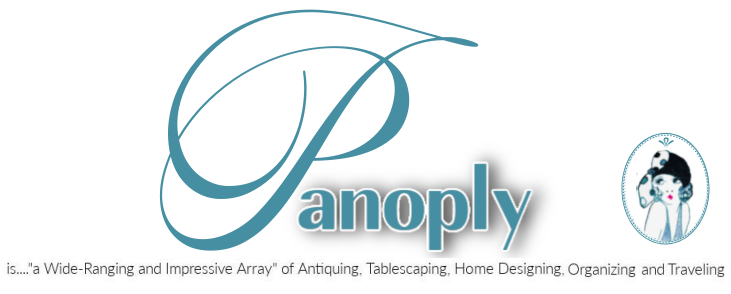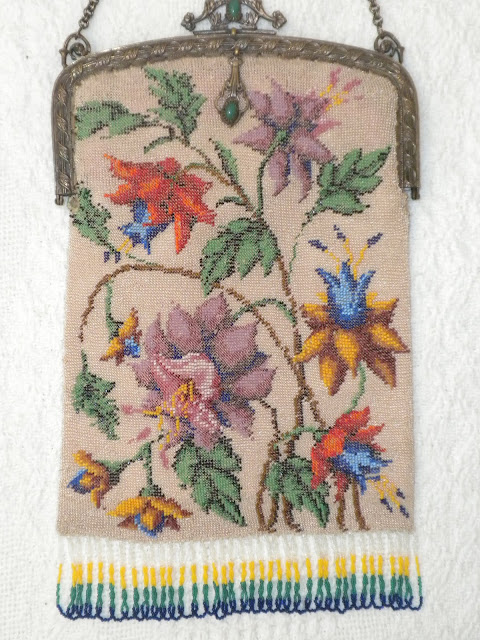Welcome to my blog, Panoply. If you are a new reader here, I am a vintage and antiques dealer, sharing rented booth space with two of my six sisters in the same antique mall for the past nearly twelve years (currently on hiatus as a non-essential business). In everyday life, I downsized our household a year ago, purging and reorganizing years of things accumulated and duplicated, so my social distancing has no real backlog of projects looming. However, tablescaping is a hobby I still enjoy, and I've readied the table for Easter. Come, join me while I dish on the details!
Today's Easter Bunnies in the Flower Garden tablescape post is an outlet - a sort of pressure relief valve - to our current state of world affairs. Just so you know, I am not living under a rock, but I created this table prior to my state's (and most of the nation's) shutdown. I have been enjoying this delightfully cheerful table in the dining space of my great room each day, and plan to continue enjoying it (minus the flowers, which are long gone) until Easter. I hope you will too. We will most likely only be sharing a quiet dinner and table for two this year.
This table was first inspired by the tablecloth I'm using. My peripheral vision was drawn right to the bright florals as I passed it on an aisle perpendicular to the one I was walking in the store. Screech! I backed up, and grabbed it. The dinner plates I had, and used previously in this table setting, here.
There are four different faces of the bunnies in the set of salad plates.
Just as I love mixing vintage with new items for table settings, I love pattern and color play too. I pulled more things from my stash, including the polka dot napkins and flatware, the checked chargers, the butterfly napkin rings, blue cake pedestal, and the blue water bottle I recently got from participating in a make-your-own workshop. I blogged on that experience, here.
The runner serves double duty. While its layer allows the floral arrangement to be highlighted on the table's center, it coordinates with (and also highlights) my napkins and flatware in color and pattern. Also [annoyingly] highlighted are some permanent packaging wrinkles in the tablecloth. That was the only drawback to its great price point. It's made of 100% polyester, and I gave up after repeatedly dampening and pressing with no luck. 🙁 I usually buy only cotton or linen blend cloths for that reason.
Colorful M&M peanut "eggs" were scattered down the runner among a string of little lights.
Each place setting has a miniature watering can place card holder, this time holding a flower packet and candy carrot umbrella for each guest.
The stemware is new, and I know I will be using this for many an occasion to come. It matches my Blenko water bottle to my satisfaction.Our great room has a definite spring vibe now. The background shows my fireplace nook and ledge, where my chicks with carts (seen recently, here) have found their place in front of the bunny with a basket full of eggs.
The table, from the bird's eye view.
Although they'd be pretty enough to serve with on the table, they're serving food, drink and lots of joy on my stovetop, especially during this #StayAtHome season.
And though the flowers are now all withered, a little bunny stole the spotlight on the table's center.
Celebrate and Decorate
Panoply (you are here!)
Create with Cynthia
Home is Where the Boat Is
Debbee's Buzz
Belle Bleu Interiors
Everyday Living
Life and Linda
At Home with Jemma
The Painted Apron
Home and Gardening with Liz
Harbour Breeze Home
Our Crafty Mom
Zucchini Sisters
Red Cottage Chronicles
My Thrift Store Addiction
Bluesky at Home
Panoply (you are here!)
Create with Cynthia
Home is Where the Boat Is
Debbee's Buzz
Belle Bleu Interiors
Everyday Living
Life and Linda
At Home with Jemma
The Painted Apron
Home and Gardening with Liz
Harbour Breeze Home
Our Crafty Mom
Zucchini Sisters
Red Cottage Chronicles
My Thrift Store Addiction
Bluesky at Home
Intelligent Domestications
Living with Thanksgiving
The Little Yellow Corner Store
Design Morsels
Calypso in the Country
Living with Thanksgiving
The Little Yellow Corner Store
Design Morsels
Calypso in the Country
For your convenience, below is a list of the elements used on my table, and the sources (no affiliations or sponsorship for me, just information for you).
Easter Bunnies in the Flower Garden Source List
Tablecloth - Pioneer Woman Fiona Floral (WalMart)
Napkins, Table Runner - Kate Spade Charlotte Street (HomeGoods and eBay)
Chargers - Parchment Check; Napkin Rings - Butterfly Garden (MacKenzie-Childs)
Dinner Plates - Mikasa Provence Garden by Kim Parker
Bunny Salad Plates - Hobby Lobby
Watering Can Place Card Holders - Ballard Designs
Vase, Pitcher, Basket (holding bunny) - Blenko
Cake pedestal, salt & pepper - vintage finds
Stemware - Wayfair
Flatware - Pfaltzgraff
Crofton Floral Teapot, Stockpot - Aldi finds (aka AOS - aisle of shame)
Flower Bouquets - Sam's Club
Chicks with carts, Bunny with eggs - MacKenzie-Childs
Copper Pitcher (with yellow blooms), Old World style bunny paintings - vintage finds
Napkins, Table Runner - Kate Spade Charlotte Street (HomeGoods and eBay)
Chargers - Parchment Check; Napkin Rings - Butterfly Garden (MacKenzie-Childs)
Dinner Plates - Mikasa Provence Garden by Kim Parker
Bunny Salad Plates - Hobby Lobby
Watering Can Place Card Holders - Ballard Designs
Vase, Pitcher, Basket (holding bunny) - Blenko
Cake pedestal, salt & pepper - vintage finds
Stemware - Wayfair
Flatware - Pfaltzgraff
Crofton Floral Teapot, Stockpot - Aldi finds (aka AOS - aisle of shame)
Flower Bouquets - Sam's Club
Chicks with carts, Bunny with eggs - MacKenzie-Childs
Copper Pitcher (with yellow blooms), Old World style bunny paintings - vintage finds
Thank you so much for your visit today. I love reading all your comments. Stay well, my friends, and Happy Easter!
Rita C. at Panoply
Sharing: Pieced Pastimes, Best of the Month, Happiness is Homemade, Love Your Creativity, BNOTP, All About Home Common Ground, All About Home Follow the Yellow Brick Home, A Stroll Thru Life, My Wee Abode, Thistle Key Lane, Bluesky at Home, The Dedicated House, Zucchini Sisters, French Ethereal SYS, Delightsome Life H&G, Katherine's Corner TFT, Grace at Home, My Thrift Store Addiction



















































